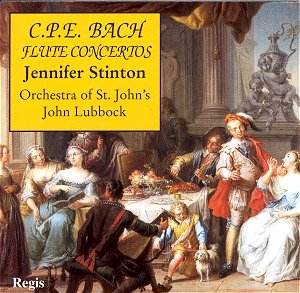This is another recording from the distinguished Collins
Classics catalogue now reissued. It arrived complete with the rave review
from Gramophone printed on the liner, leaving the poor reviewer
with little to do but agree enthusiastically after a single very enjoyable
hearing. To paraphrase that review and call it my own would be dishonest
and to reprint it would be an evasion and might bring us a bill for
royalties or land us in an infringement action.
To find something to do to earn my bread, I re-listened
to the James Galway recording of this same repertoire, accompanied by
Jörg Faerber and the Württemburgisches Kammerorchster Heilbron.
Both flautists are British and both play with astounding virtuosity
both in the rapid passage work of the fast movements as well as in the
long phrases of the slow movements. Both orchestras perform the fast
movements with a high energy driving beat in the tense Stürm
und Drang style, what the composer would possibly have described
as "old fashioned," with Faerber obtaining a slightly sweeter
and more varied sound and Lubbock obtaining a slightly more "Baroque"
orchestra sound. Both orchestras play the slow movement accompaniments
with deep affect and drama. Galway ornaments the slow movements more
elaborately than Stinton and his phrasing is slightly more lyrical and
more openly emotional. C.P.E. Bach probably would have liked this "modern"
performance better. Stinton and Lubbock make C.P.E. Bach sound just
a little more like J. S. Bach, stressing the threads of his fatherís
style that survive in his music, and this to a contemporary audience
is probably a good thing.
The Flute Concertos also exist in harpsichord concerto
versions (in respective order, H. 426, H. 438, H. 445) but these versions
have not been included in the "complete" harpsichord concerto
recording by Miklos Spanyi and the Concerto Armonico. While this prevents
me making a direct comparison, it suggests that Mr. Spanyi felt that
the flute versions were to be preferred and he saw nothing to be gained
by duplicating them on the harpsichord.
This is an exceptionally fine recording of this repertoire,
but if you already own the Galway/Faerber version, you can be content
with it.
Paul Shoemaker
